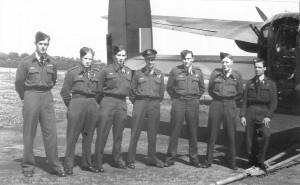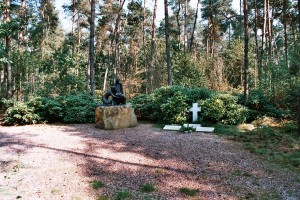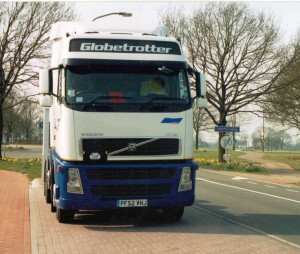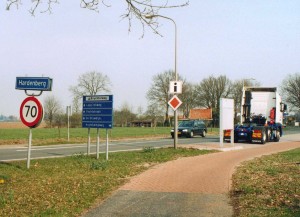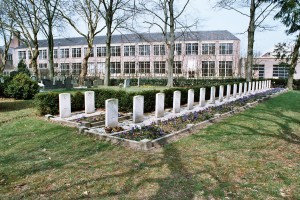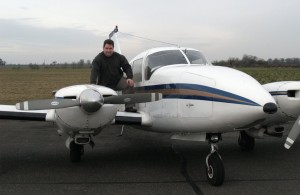INTRODUCTION
About this website
This is the story of a bomber crew from RAF 100 Squadron, a somewhat typical cross section of the cream of British and Commonwealth youth from a multitude of social classes and backgrounds. Just one crew, one of many like them who were shot down in flames over occupied Europe during WWII. This particular bomber crew contained eight men, of whom four perished in the crash and four managed to successfully parachute to safety. The focal point of the story is the remarkable fate of one of the survivors of the crash, the crew’s navigator F/O Gerald Hood, whose story along with that of his comrades gives us some insight into the lives and deaths of the many thousands of allied aircrew who fought in the skies during the European air war.
Our Purpose
We aim to present this particular crew as an example, then to hold them up as a symbolic tribute to all who flew with Bomber Command during WWII whatever their country of origin, in particular to the 55,573 who took to the air and paid the ultimate price, never to return and fulfill their potential in life during the peace that was to follow. We also wish to pay tribute to those who survived and went on to live their lives dealing with the consequences and the memories of their time as airmen at war.
The Eternal Controversy
Those of us who were born later inherited a hard won freedom from the generation of our fathers/grandfathers who were called upon to fight a total war and inevitably, a climate of such freedom of speech and thought gives rise to those voices who (as is their right) will question the actions (and their consequences) of those who flew into battle particularly with Bomber Command. Those of us involved in the production of this website are only too aware of the political/ historical origins and indeed the consequences of the aerial offensive on mainland Europe conducted from our shores during the Second World War, we do not seek to analyse or question the strategies or decisions of those in government/high command at the time or glorify the agonies and losses of those on the receiving end of Sir Arthur Harris’s “Whirlwind.” (The Nazis entered this war under the rather childish delusion that they were going to bomb everyone else, and nobody was going to bomb them. At Rotterdam, London, Warsaw, and half a hundred other places, they put their rather naive theory into operation. They sowed the wind, and now they are going to reap the whirlwind. – Marshal of the Royal Air Force Sir Arthur Travers Harris, 1st Baronet GCB OBE AFC RAF)
We only seek to honour the memory of those who did their duty and offered their lives in the name of freedom, those whose lives were taken and those who were spared.
About the Author
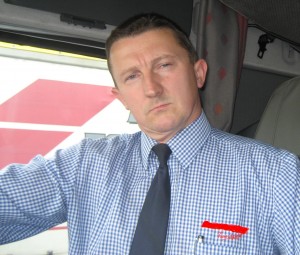 This is also the story of an Englishman abroad treading in the footsteps and pursuing the story of a long dead and heroic fellow Englishman from another time. Although I have to concede that this adds an interesting twist, I do not intend to give the impression at any point that the story is in any way about me, but I consider myself very fortunate indeed to have been that Englishman abroad.
This is also the story of an Englishman abroad treading in the footsteps and pursuing the story of a long dead and heroic fellow Englishman from another time. Although I have to concede that this adds an interesting twist, I do not intend to give the impression at any point that the story is in any way about me, but I consider myself very fortunate indeed to have been that Englishman abroad.
 I started writing this website at the close of 2008 as I was racing comfortably towards my mid-forties. I have spent all of my working life in the road haulage industry, both hands on as an HGV driver and briefly in an administrative role (driving a desk!), this is more than just a job to me it has been a career and a way of life. I have been with my current employer for a good while now, we are a small but long established, private company based in West Lancashire involved in specialised UK and International transport for our customer located near to the City of Preston, Lancashire with regular runs to Holland, Germany, France and Belgium, this is relevant because it was my work that initially gave me access to the places that inspired me to pursue this story. I possess no qualifications in journalism at any level and hope I do not come across as pretentious in any way for pursuing this story, I simply write and correspond for pleasure on various subjects that concern and interest me in the capacity of no more than a keen amateur.
I started writing this website at the close of 2008 as I was racing comfortably towards my mid-forties. I have spent all of my working life in the road haulage industry, both hands on as an HGV driver and briefly in an administrative role (driving a desk!), this is more than just a job to me it has been a career and a way of life. I have been with my current employer for a good while now, we are a small but long established, private company based in West Lancashire involved in specialised UK and International transport for our customer located near to the City of Preston, Lancashire with regular runs to Holland, Germany, France and Belgium, this is relevant because it was my work that initially gave me access to the places that inspired me to pursue this story. I possess no qualifications in journalism at any level and hope I do not come across as pretentious in any way for pursuing this story, I simply write and correspond for pleasure on various subjects that concern and interest me in the capacity of no more than a keen amateur.
Why, as a boy of only seven years old did I become so fascinated by air warfare? I think over forty years later I finally know, it was in my blood. My dad Harry passed away in 1995 without ever telling me of what he experienced in his hometown of Bootle, Liverpool during his eighteenth year, despite the fact that we were very close. I have discovered since his death that during 1941, just before he volunteered for His Majesty’s Navy he witnessed at close quarters the May blitz on the City of Liverpool including the destruction of his home, street, school, church, workplace and all the places in and around where he grew up and of course the souls who perished here were his friends and neighbours. Of course that is another story, but this experience clearly affected dad deeply and it was a period of his life that was always a firmly closed book, but somehow I believe he passed something on to me that lives in my sub-conscious and this is part of the reason for my depth of interest. Many of life’s threads have come together here for me! My depth of interest may also have something to do with my uncle, Flt/Sgt James “snowdrop” Southworth and his two tours as a rear gunner with 78 and 103 Sqdns, again…. another story!
I did come close to serving in Her Majesty’s Air force but it was not to be and a different path in life beckoned. Nevertheless I have always held a deep fascination and awe for the men who fought in the air, especially during the conflict of 1939 to 1945, though for many years my interest in such matters had remained I admit, rather passive, but that was all to change as good old-fashioned, boyish hero-worship suddenly began to evolve into a more grown-up commitment to play a part however small in ensuring that the men who fought and died this way would always be remembered for their sacrifice.
Where it all began
For me, the LM658 story began on a sunny Sunday afternoon back in August 2001 during another overseas trip and this particular weekend I was exploring the local area walking on the outskirts of the village of Zenderen, near our base at Almelo in the province of Overijssel, Eastern Netherlands. I had taken a path leading through woodland known locally as De Vloedbeld. I emerged into a clearing and was confronted by an impressive bronze memorial statue, nearby on the ground were three white tablets laid in memory of local Dutch patriots who lost their lives resisting the Nazi occupation, one of these tablets however, bore the name and date of birth of a Royal Air Force officer. My curiosity was aroused, for here in this pleasant peace of Dutch woodland was a tribute to a fellow countryman who had passed this way before me in very different circumstances.
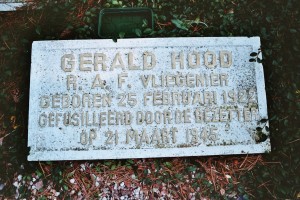
Flying Officer Gerald Hood (Navigator LM658) 1922-1945 “Gefusilleerd Door De Bezetter” (Executed By The Invaders)
Flying Officer Gerald Hood. I never knew him, his life ended prematurely two decades before mine began and over fifty-five years before I ever set foot in Almelo. From the moment I first wandered into that clearing the quest began for me, on that day I was moved to make it my business to get to know all about F/O Gerald Hood, how he came to be here and how his life ended. I felt obliged to bring home the story of this fellow countryman who, many years ago set out from an airfield in eastern England to meet his fate. After some initial research my need to know was heightened when it became apparent that Hood’s story was very much a mystery in his country of birth, if indeed it had ever been told at all!
On that August afternoon when I first discovered the memorial in that often quoted “corner of a foreign field that will be forever England” (Rupert Brooke) I decided it was my duty to see that Gerald Hood’s story was “brought home.” for this was clearly a story that must be told. Tens of thousands of allied airmen paid a similar price, but as I was soon to learn this story does have many unique qualities. Gerald Hood survived being shot out of the sky in flames and with the help of the people of occupied Holland he evaded capture for months, with liberation and the end of hostilities less than two weeks away, this young English officer became the victim of a cold-blooded, execution at the age of just twenty-three.
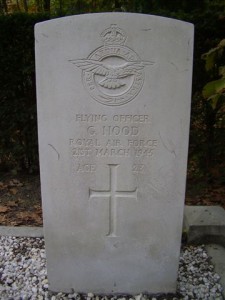
Gerald Hood’s headstone at Almelo cemetery showing the recent addition of his age (23), thanks to the efforts of Mr Brian Angel of the Old Russellians committee.
On Location
I consider myself to be most fortunate that in recent years my work has regularly taken me to the Almelo/Hengelo area of the eastern Netherlands, an area for which I have a great affection and since my first discovery back in 2001 of the memorial in De Vloedbeld near Zenderen I have been back to that woodland clearing many times and of course have also made several visits to Gerald Hood’s grave in the Almelo General cemetery, both sites in easy walking/cycling distance from our local base.
During initial research I had discovered the location of the crash site and the final resting place of four other crew members, which was prohibitively far to the north so I wondered if I would ever get the chance to visit, I had to wait a while for the answer. My chance came one Friday in the spring of 2004, when an opportunity presented itself in the form of a “stand-down” workday situation, so with the full permission of my employers I detached from my semi- trailer and set off (tractor unit only) on the road north out of Almelo through the typically Dutch countryside towards the village of Bergentheim. On approach to the village I was able to look west across the open farmland to the approximate spot where the blazing wreck of LM 658 had crashed down way back in the summer of 1944.
I then continued north into the town of Hardenberg to locate the graves of the four crew members of LM658 that had perished in the crash. Hardenberg has a total of three large cemeteries and it was (somewhat typically) the third one I visited that contained all of the Commonwealth War Grave Commission burials, I soon found the lines of uniform white headstones and immaculately tended plots, for here besides the four men I was seeking lay many other allied aircrew, including a couple of other complete Lancaster crews. I then got my chance to pay silent tribute in front of the graves of four men who I felt I knew well, but in reality, I had never met! I returned to Almelo with a renewed determination to write the story of not only Gerald Hood, but the whole crew of LM 658.
Acknowledgements
At the close of 2001 the Gerald Hood story seemed to be a mystery to everyone I spoke to back in the UK, all I really had to work with was a couple of photographs of the memorial site. After a bit of basic internet detective work and a letter to the 100 Squadron Association, I was put in touch with Mr Greg (“me big Welsh mate”) Harrison of Cardiff, who at the time was the historian and webmaster to the 100 Squadron Association, Greg had by coincidence also started his own work into the Gerald Hood story, so naturally we pooled resources. During the course of the research I was delighted to be recommended to the committee of the 100 Squadron Association by Greg Harrison, for an associate membership, the recommendation was accepted, an honour rarely bestowed on anyone who has never served or is not directly related to a current serving or former member of the squadron.
Thanks also to my employers for enabling me to be in Europe, conduct my research and undertake various visits to crash/burial sites during what was effectively their time.
We have had invaluable help and support from numerous other sources including Mr Laurence Pilfold (nephew of Flt/Sgt Laurence Watts), Mr Alan Paston-Williams (son of Flt/Lt Harold “Bill” Paston–Williams), Mr Tom Wilson (lifelong friend of Flt Sgt John Downie) and Mr Ian Reid, author of the book “To Fly Over Waltham.” During 2007 associates of The Royal Russell School in Croydon, Mr Brian Angel and the late Mr Derek Card (who sadly passed away at the end of 2007) took the investigation to areas and levels that were way beyond my own resources. Thanks also to Theo Boiten and John Manrho and their excellent and extensive work on Luftwaffe night fighter claims. Further factual information was also obtained and/or cross-checked from the Commonwealth War Graves Commission website, 100 Squadron operational records, transcripts of the UN War Crimes Commission trials and WR Chorley’s Bomber Command Losses. Not forgetting the local people of Almelo and the surrounding area that have kept Hood’s story very much alive… and always will, especially Mr Martin Vloedbeld and the Zenderen Liberation Committee!
The obvious next step was to give the whole story a WWW presence, this has been made possible by Mr Duncan Reid, proprietor of The Duncan Reid Consultancy in Liverpool who, as a result of his own enthusiasm for aviation history has given his professional time, technical know-how and resources in website design, construction and hosting in exchange for an up-front fee of tea and bacon sandwiches!
Since the website has been online we have had valuable contact and much support from Mrs Zoe Smales and family (Gerald Hood’s living relatives), Mrs Joanna Newton, (sister of Flt Lt Christopher Holland) and her son Mr Christopher Newton, Flt Sgt Roy Fellows (RAF 61 Sqdn retired), F/O James Boyle (RCAF 625 Sqdn retired) and his daughter Mary Phelan, Carla Woodworth-Lynas (daughter of Flt Lt Carl Woodworth), John Michel (grandson of F/O Stevie Stevens) and Mrs Anne Merritt and family (daughter of P/O Benjamin Ramsden).
In late August 2012 we received a very significant contact from medal collector Mr Richard Jones, who has kindly supplied us with photos of the medal collection of LM658’s flight engineer, John Downie of which he is custodian. More notable still, Mr Jones has also supplied copies of some key, significant documents that had so far eluded us, including more detailed notes from the escape and evasion reports/de-briefings of John Downie and Bill Paston-Williams respectively, completed on their return to the UK. As a result of the remarkable information supplied, we have been able to fill in some big gaps and confirm some details of which we were already partially aware of, enabling us to give the fascinating chronology of events that took place during that last, fateful flight of LM658 and her crew, as outlined in The Hood Story section of the website.
Early in 2015 I received the contact I had been waiting for from Mrs Christine Jones, who whilst researching her husband’s family tree in the North Wales area, became intrigued by the treasured photo of the young airman that had always been on display in the home of his grandmother. After some further research, Christine came across the LM658 website and from there we had contact with the family of Stan Williams, our mid-upper gunner. Sincere thanks to Mrs Pauline Ellis (Shone) and family for the information supplied and for allowing us to use Stan’s photo and flying log.
Also during 2015, we were delighted to correspond with Mr John Krispyn, born in the Netherlands and growing up in time of occupation, his stunning account of life as a boy in occupied Almelo and his eyewitness account of the crash of another Lancaster (ME732) on the town is included in an appendix on the website.
Thanks to our webmaster Duncan we have also been able to add information provided by Mnr Leon Baars, the son of Marie Baars-Kroeze, one of the very special people on the ground in the occupied Netherlands, who sheltered allied airmen within their own families at huge personal risk, to these courageous and kind people so much is owed. This material was thought to have been lost in a hard-drive meltdown a few years back, but it has now been recovered.
After another long period of little progress, a steady stream of information started to come our way with regards to the Canadian rear gunner Bruce Arnold David, further invaluable help from Mrs Christine Jones and her contact Mel, over in Ontario, gave us some key breakthroughs. Then at last we had contact, quite by chance from Dr Dale Palko a nephew of the David brothers who was also researching their service careers. Finally… we had reckoned without Mr David Champion, the 101 Squadron specialist, who kindly accessed and provided the wealth of quality research information that enabled us to complete the story of the crew of LM658.
To all the above mentioned people and everyone else who has commented and contributed your help and enthusiasm has been a joy and a pleasure,
THANK YOU
Here, the sixteen year long quest ends, we have told their stories and for the five crewmen who lie in well-tended Dutch graves, it really feels like we have brought them home. Our job is done, but we will always be available to receive new information or amplifications and clarifications on any points of this extended story and of course we always welcome contact from any interested parties, particularly relatives and family historians.
This is the story of a bomber crew, of eight young men, three of whom lived and five of whom died, eight men out of so many more just like them. So let it stand as a tribute to all of the men who flew operationally with RAF Bomber Command during those dark days, those who never got to grow old and those who grew old dealing with the aftermath of their experiences, physical and mental.
They chipped in everything they had to pay for our freedom.
Per Ardua Ad Astra
For Derek, an avid researcher and a true gentleman
